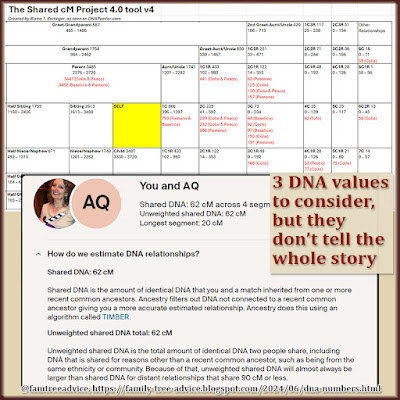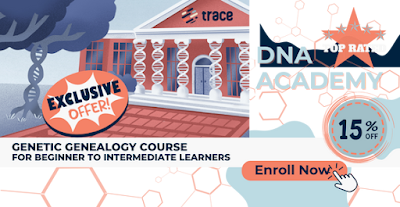Trying to solve a mystery DNA match? An extensive family tree is more important than the centiMorgans (cMs) you share. Often it's only when you place a match in your family tree that you see your true relationship.
 |
| When you look at the different values assigned to your DNA matches, which number matters most? My answer isn't what you'd expect. |
When I want to figure out a new DNA match, I consult the Shared cM Project tool created by Blaine T. Bettinger. You can find it on the DNA Painter website. The tool can suggest your likely relationship to a DNA match based on the number of cMs you share. The chart itself tells you:
- the average number of cMs you might share with a type of relative
- a likely range of cMs you can expect to see for each type of relative.
My family tree has tons of cousins with more than one relationship to me. Our roots are so deep in one little town that we're related to everyone who lived there. I want to see how all the intermarriage in my little towns might affect my DNA numbers.
Seeing How Your DNA Matches Score
For this exercise, I copied Bettinger's Shared cM chart into a spreadsheet so I can add cM values for my DNA matches. (This copy is available for you to download.) For each match that I added to the chart (in red ink), I included the hometown(s) of our shared ancestors. The town name showed that I have a higher number of shared cMs with cousins connected to Pastene, Italy.
One reason for this higher amount of DNA may be the small size of this hamlet. It's basically one street! Families were intermarrying there for hundreds of years. My great grandparents Giovanni and Maria Rosa came from Pastene. Some of their descendants and their siblings' descendants have tested with AncestryDNA.
I must say I expected to see lots of DNA matches with cMs that went far above the range in the Shared cM Project tool. Since I have multiple relationships with so many people, I thought the cMs would stack up higher. In reality, I found only one match who went above the cM range—a 6th cousin twice removed.
This DNA match (A.S.) shares 58 cM with me when the average for our relationship is 13 cM and the range is 0 to 45 cM. Here's why our shared cMs are high. A.S. and I share:
- my 5th great grandparents Innocenzo and Anna (that's the 6C2R relationship)
- my double 6th great grandparents Giuseppe and Maria (that makes A.S. my 7C1R)
- my 7th great grandparents Pasquale and Maria (that makes A.S. my 8C1R)
- my 7th great grandfather Giancamillo (that makes A.S. my 8C2R)
It seems shared cMs alone can't predict complex relationships every time.
 |
| This chart shows a higher concentration of shared DNA coming from one of my ancestral hometowns. What will yours show? |
Exploring Another Variable
"Unweighted shared DNA" is a factor when you have deep roots in the same place or ethnicity.
If you have an AncestryDNA account, you can view this value for any DNA match in your list. Click the blue, linked description beneath their relationship label. For instance, for my 3rd cousin, I see "82 cM | 1% shared DNA."
Looking at my DNA match A.S., I see that we:
- share 58 cM across 3 segments
- have a longest segment of 30 cM
- have 60 cM of unweighted shared DNA—2 cM more than the 58 cM of shared DNA.
You may be as curious about the unweighted shared DNA as I am. Here's AncestryDNA's definition:
So that's why so many DNA matches appear to be closer than they are. I knew there was some extra DNA just from having deep roots in the same soil, but this puts a value on it.
To test this out, I looked at the DNA breakdown for lots of my identified DNA matches. In general, the unweighted shared DNA for my 3rd cousins or closer was exactly the same as their shared DNA. Many of my more-distant cousins had from 1 to 5 cM more unweighted shared DNA than shared DNA. But some of the distant cousins didn't have any extra unweighted shared DNA at all.
Searching for the Magic Number
Unweighted shared DNA isn't enough to help us understand our relationship to a DNA match. So I looked at the third value: longest segment length. DNA experts say you should be able to identify a match with a longest segment of 50 cM or more. But I have only 40 matches with numbers that high.
Here's a small sampling of the under-50 shared cM DNA matches I've identified and placed in my family tree. These are not people I know or grew up with. Most have a very small family tree online. But thanks to my family tree, I found their grandparents or great grandparents.
- 5C1R, 48 cM, longest segment 10 cM
- 9C, 27 cM, longest segment 12 cM
- 5C2R, 41 cM, longest segment 13 cM
- 7C, 30 cM, longest segment 14 cM
- 6C, 26 cM, longest segment 15 cM
- 3C1R, 39 cM, longest segment 16 cM
- 5C1R, 24 cM, longest segment 18 cM
- 5C, 26 cM, longest segment 20 cM
Notice we share from 24–48 cM, and our longest shared segments range from 10–20 cM. AncestryDNA categorizes these matches as 4th–6th cousins or 5th–8th cousins. I was able to get so much more specific despite those short longest segments.
Well would you look at that? Here I am, yet again, hyping the value of a gigantic family tree. I like to crack new DNA matches to see what happened after the Italian vital records end. Who came to America? Who went to Canada, England, or Australia? Do people with roots in my Italian towns live near me today?
In the end, the best way to crack DNA matches is with your extensive, full-blown family tree.
And speaking of cracking DNA matches:
 |
| A 15% discount for readers of Fortify Your Family Tree! |
Thank you, DiAnn, for the download capability of the Shared cM Chart!
ReplyDeleteI'm sure there are other ways we can use it, now that we can "write" on it!
Delete